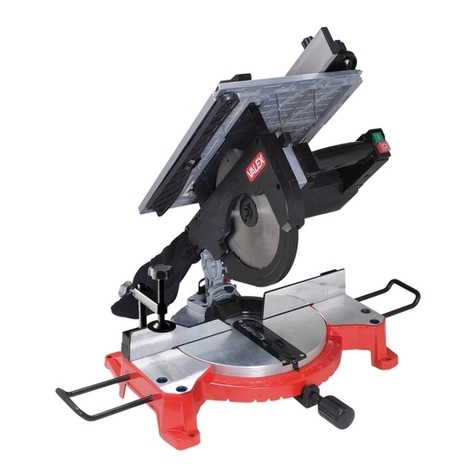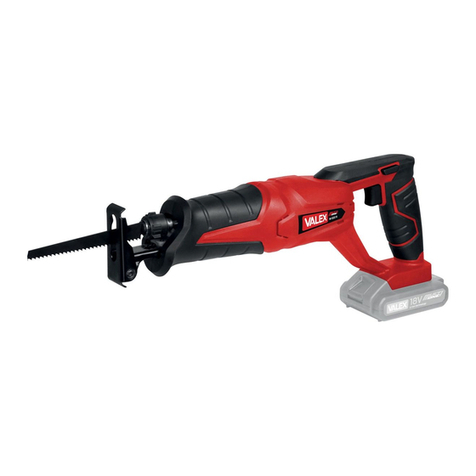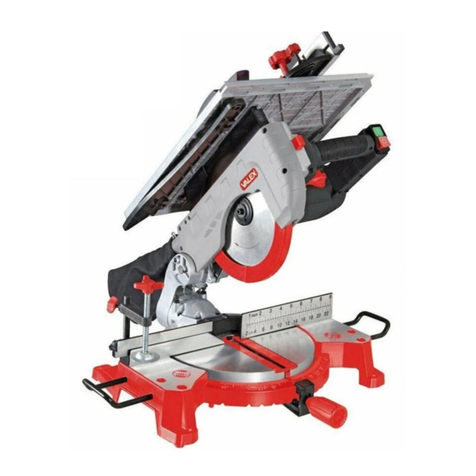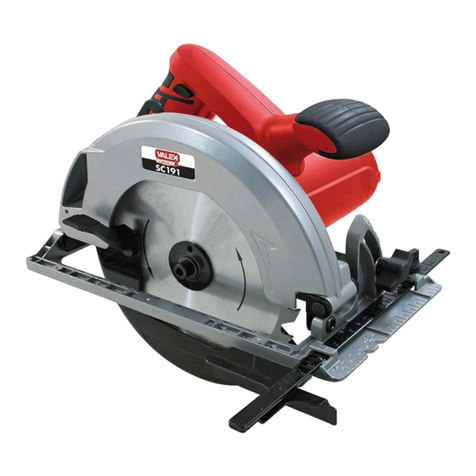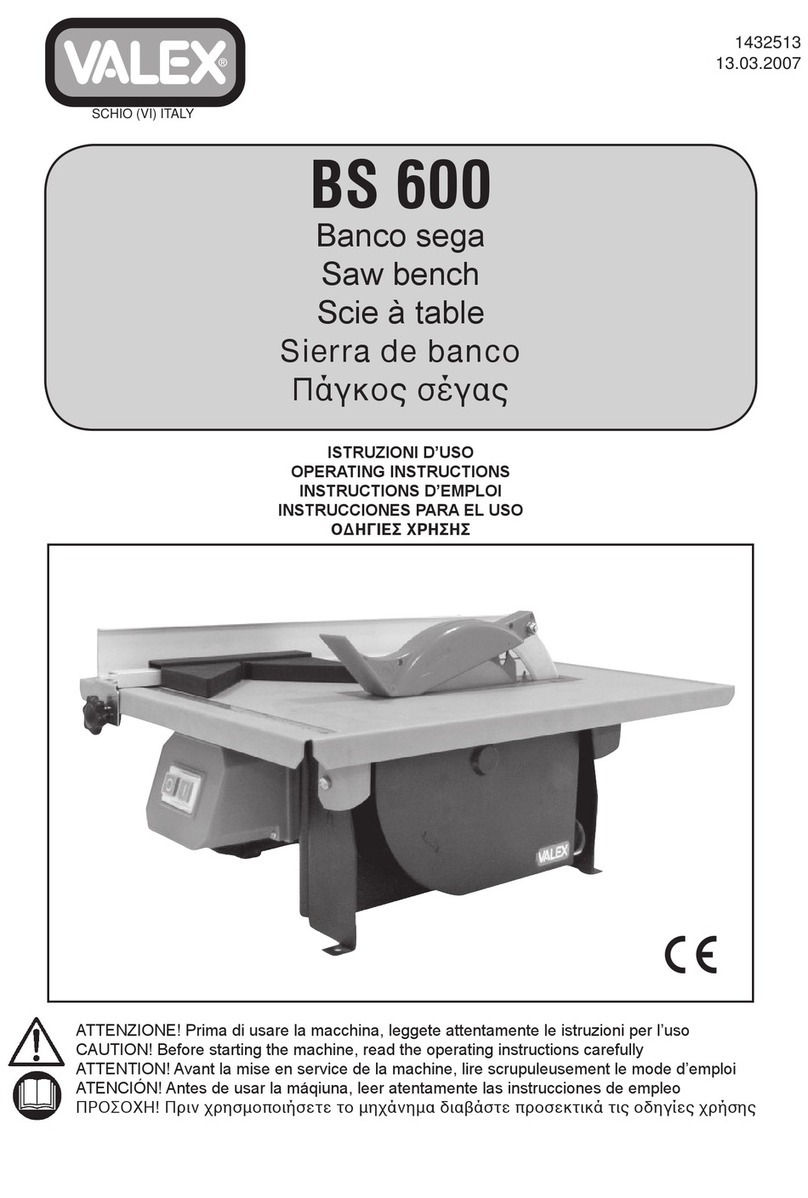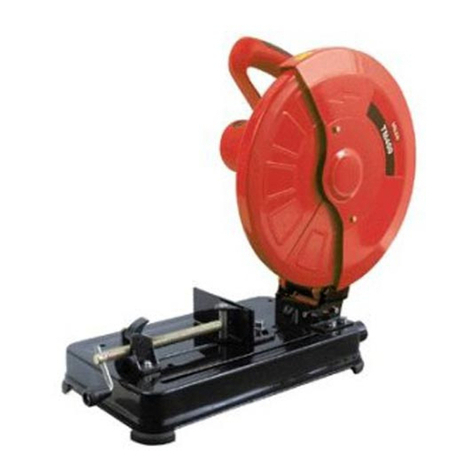
- 8 -
e la sua durata sarà breve fino al mancato
funzionamento. Durante l’avanzamento non
arretrate e non inclinate lateralmente l’utensile.
6Al termine del taglio spegnete l’utensile,
attendete l’arresto completo, sollevatelo dal
pezzo (se non già uscito dalla parte opposta),
appoggiatelo al banco e scollegate la spina
dall’alimentazione elettrica.
Se la lama si blocca dentro il pezzo, spegnete
immediatamente l’utensile e con un attrezzo divari-
cate la gola di taglio per liberare la lama ed estrarla.
Nel taglio dei metalli raffreddate costantemente
la lama versando delle gocce di olio da taglio
(non incluso), in caso contrario si avrà una
veloce usura del tagliente. Attenzione: non ec-
cedere con la quantità di liquido e non versarlo
sull’utensile elettrico.
Per eseguire dei tagli chiusi, ad esempio una
apertura (circolare, quadra ecc.), eseguite con
un trapano un foro all’interno della zona da
asportare (Ø foro > larghezza lama), afferrate
l’utensile ed infilate la lama dentro al foro appena
eseguito; da qui avviate e procedete con il taglio.
Nei tagli curvilinei procedete lentamente per non
flettere la lama.
Per tagli su pannelli in verticale, iniziate dalla
parte alta per proseguire verso il basso; in
questo modo i trucioli e la polvere tenderanno
a cadere nel pavimento e non verso di voi o
verso l’utensile.
I tagli a soffitto devono essere eseguiti con
estrema cautela ed attenzione: indossate un
casco a protezione del capo. Non eseguire
questo tipo di taglio su pannelli che producono
polvere (legno ecc.).
MANUTENZIONE
ATTENZIONE! Prima di ogni controllo o
regolazione scollegate la spina dalla presa di
alimentazione elettrica.
ATTENZIONE! Non manomettete o tentate
di riparare l’utensile elettrico.
ATTENZIONE! Una eventuale revisione
interna o la sostituzione delle spazzole in
grafite del motore che si usurano con l’uso,
deve essere effettuata solamente da un centro
assistenza autorizzato.
La durata e il costo d’esercizio dipendono anche
da una costante e scrupolosa manutenzione.
Pulite regolarmente ed abbiate cura del vostro
utensile elettrico, vi garantirete una perfetta
efficienza ed una lunga durata dello stesso.
- Rimuovete la polvere e i residui di lavorazione
con uno straccio e un pennello a setole morbide.
- Non spruzzate o bagnate d’acqua l’utensile
elettrico, pericolo di infiltrazioni interne.
- Non usate infiammabili, detergenti o solventi
vari. Le parti in plastica sono aggredibili da
agenti chimici.
- Eliminate eventuali tracce di resina che si
depositeranno sull’utensile.
- Prestate particolare attenzione alla pulizia
dell’interruttore, alle feritoie di ventilazione del
motore, alle impugnature, al portalama.
- Lubrificate il portalama con poco olio spray.
SOSTITUZIONE DELLA LAMA
ATTENZIONE! Prima di ogni sostituzione spe-
gnete l’utensile, attendete l’arresto e scollegate
la spina dalla presa di alimentazione elettrica.
ATTENZIONE! A fine utilizzo la lama rag-
giunge temperature elevate: attendete il suo
raffreddamento prima di sostituirla.
ATTENZIONE! Le parti taglienti provocano
gravi ferite, utilizzate i guanti di protezione!
ATTENZIONE! Il montaggio della lama deve
essere eseguito a perfetta regola d’arte. Un
montaggio errato genera pericoli molto gravi.
Prima di procedere osservate attentamente i
componenti dell’utensile e la fig.C. Se non avete
dimestichezza con la manipolazione e l’assem-
blaggio di componenti meccanici, vi consigliamo
di rivolgervi ad un centro assistenza autorizzato.
1. Indossate i guanti a protezione delle mani.
2. Scollegate la spina dalla presa di alimenta-
zione elettrica.
3. Effettuate una accurata pulizia nella zona del por-
talama, utilizzando uno spazzolino non metallico.
4. Azionate il dispositivo di aggancio lama (5)
ruotando l’anello (vedi fig.C)
5. Tirare verso l’esterno la lama (5).
6. Se necessario pulite la sede portalama.
7. Afferrate la nuova lama (5) nella parte dentata
e lubrificate con un leggero strato di grasso
l’estremità sagomata
8. Mantenendo azionato il dispositivo di aggan-
cio, infilate a fondo l’estremità sagomata nella
feritoia del portalama. Il lato dentato della lama
dovrà essere rivolto verso il basso rispetto
l’utensile (fig.A).

